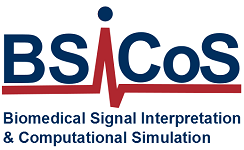-
Projects
ECG morphology clusters for sudden cardiac death risk stratification in coronary artery disease using genetics and human-based computational models (STRATEGIC) – PID2021-128972OA-I00
Start date
2022
End date
2024
Coordinator
Ana Mincholé & Julia Ramírez
Funding agency
Ministerio de Ciencia e Innovación y cofinanciado por la Unión Europea (FEDER)
Coronary artery disease (CAD) is a leading cause of mortality worldwide with 17.8 million deaths annually. Sudden cardiac death (SCD) is a devastating event, often attributed to life-threatening ventricular arrhythmias (LTVA), occurring the vast majority (up to 80%) in patients with underlying CAD. Unfortunately, despite advances in prevention and treatment, SCD remains a leading cause of mortality.
The electrocardiogram (ECG) provides a non-invasive measurement of the electrical activity recorded at specific locations on the patient’s torso. Two key electrophysiological mechanisms involved in the development of LTVA in CAD are non-uniform propagation and increased dispersion of repolarization, affecting the QRS and T-wave morphologies on the ECG. Several ECG indices based on time intervals have been proposed as SCD predictors in the context of CAD. However, their predictive value is still limited and, importantly, they are also associated with non-SCD, limiting their clinical translation. Non-invasive, accurate and specific SCD risk predictors easily measured from a standard 12-lead ECG are needed for large-scale screening and potential clinical application. STRATEGIC stands on an accurate ECG characterization in CAD based on ECG morphological clusters to address SCD risk stratification and, ultimately optimize the tailored treatment of CAD patients.
Genome-wide association studies (GWAS) have recently been successful in identifying genetic variants for ECG indices in the general population. Importantly, multiscale computational models of the human heart are powerful tools to integrate genetic, anatomical and electrophysiological information for the investigation of the electrophysiological function of the heart. STRATEGIC will integrate the information from the genetic architecture of the distinct ECG morphological clusters to understand the mechanisms underlying SCD risk. To do so, biophysically detailed computational models will be informed with patient specific data for the investigation of key arrhythmic mechanisms in each cluster.
We have access to different databases to perform our analyses: a large database of more than 100.000 patients from the UK Biobank and a cohort of ~100 patients during percutaneous coronary intervention to perform our primary investigations, and two different clinical databases to validate our findings: a cohort of ~2,000 CAD patients and a cohort of ~1,000 heart failure patients (50% with CAD), both with a 5-year follow-up.
The ultimate goal of STRATEGIC is to blindly identify distinct ECG morphological clusters of SCD risk based on the overall morphology of QRS and T wave of CAD patients from standard 12-lead ECGs uncorrelated to other known and non-modifiable risk factors as age and sex, and to investigate their underlying arrhythmogenic mechanisms. STRATEGIC is placed at the forefront in integrative human physiology and involves the combination of different technical fields: ECG signal analysis to develop novel biomarkers based on QRS and T wave morphologies; machine learning for developing unsupervised clustering strategies, statistical genetics and bioinformatics for the association between genetics and ECG, and computational modelling for the simulations of the electrical activity integrating data at different scales. STRATEGIC will be paramount to further elucidate mechanisms of SCD in CAD with concomitant economic and social benefits to human health.
